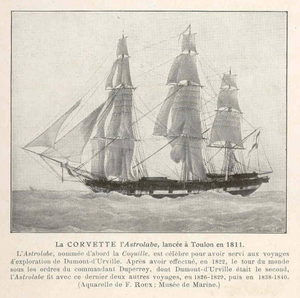
Jean François de Galaup, comte de Lapérouse, often called simply Lapérouse, was a French naval officer and explorer. Having enlisted at the age of 15, he had a successful naval career and in 1785 was appointed to lead a scientific expedition around the world. His ships stopped in Chile, Hawaii, Alaska, California, Mauritius, Reunion, Macau, Japan, Russia and Australia before wrecking on the reefs of Vanikoro in the Solomon Islands.

Jules Sébastien César Dumont d'Urville was a French explorer and naval officer who explored the south and western Pacific, Australia, New Zealand, and Antarctica. As a botanist and cartographer, he gave his name to several seaweeds, plants and shrubs, and places such as d'Urville Island in New Zealand.

La Perouse is a suburb in the Eastern Suburbs of Sydney, in the state of New South Wales, Australia. The suburb of La Perouse is located about 14 kilometres (8.7 mi) southeast of the Sydney central business district, in the City of Randwick.

Jean Baptiste Alphonse Déchauffour de Boisduval was a French lepidopterist, botanist, and physician.

René Primevère Lesson was a French surgeon, naturalist, ornithologist, and herpetologist.
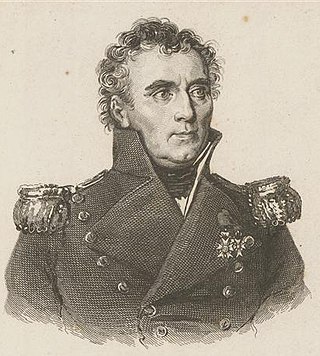
Louis-Isidore Duperrey was a French naval officer and explorer.
Honoré Jacquinot was a French surgeon and zoologist. Jacquinot was the younger brother of the naval officer Charles Hector Jacquinot, and sailed with him as a surgeon and naturalist on La Zelée on Dumont d'Urville's Astrolabe expedition (1837–1840).
Cyrille Pierre Théodore Laplace was a French navigator famous for his circumnavigation of the globe on board La Favorite. He was pivotal in the opening of French trade in the Pacific and was instrumental in the establishment of the Hawaiian Catholic Church. He achieved the rank of captain.

The French Antarctic Expedition is any of several French expeditions in Antarctica.
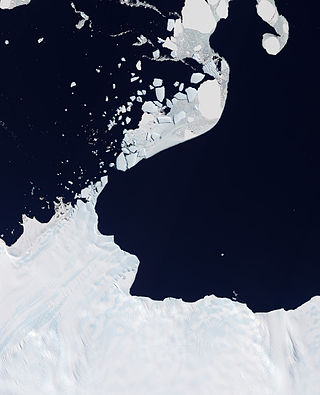
Astrolabe Glacier is a glacier 10 kilometres (10 km) wide and 19 kilometres (10 nmi) long, flowing north-northeast from the continental ice and terminating at the coast in a prominent tongue at the east side of Geologie Archipelago. It was first sighted in 1840 by the French expedition under Captain Jules Dumont d'Urville, although no glaciers were noted on d'Urville's chart of this coast but a formidable icy dike with perpendicular flanks of 37.7 m high according to the joined plate, corresponding to the glacier tongue. The glacier was photographed from the air by U.S. Navy Operation Highjump in January 1947. It was charted by the French Antarctic Expedition, 1949–51, and named after d'Urville's flagship, the Astrolabe.

François Edmond Eugène de Barlatier de Mas was a French naval officer.
Débarquement Rock is an ice-free rock 200 metres (220 yd) long and 18.7 m high, marking the northern end of the Dumoulin Islands and the north-eastern end of the Geologie Archipelago.
Charles Hector Jacquinot was a noted mariner, best known for his role in early French Antarctic surveys.
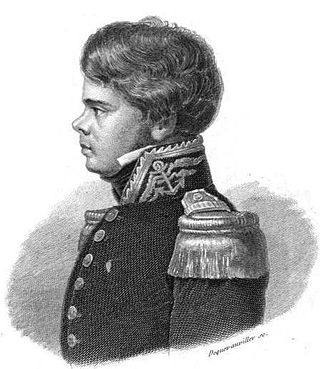
Jules Poret de Blosseville was a French naval officer, geographer and explorer. Born in 1802, he joined the French Navy at the age of 16. From 1822 to 1825, he participated in an expedition that explored the South Pacific and, by its conclusion, circumnavigated the world. He disappeared in August 1833, while in command of his own expedition to the Arctic.
A summary of 1822 in birding and ornithology.

The era of European and American voyages of scientific exploration followed the Age of Discovery and were inspired by a new confidence in science and reason that arose in the Age of Enlightenment. Maritime expeditions in the Age of Discovery were a means of expanding colonial empires, establishing new trade routes and extending diplomatic and trade relations to new territories, but with the Enlightenment scientific curiosity became a new motive for exploration to add to the commercial and political ambitions of the past. See also List of Arctic expeditions and List of Antarctic expeditions.
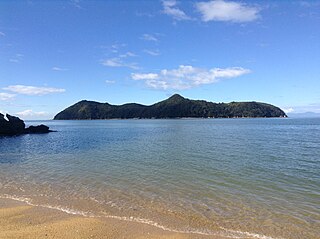
Motuareronui / Adele Island is a small island off the coast of New Zealand. It is contained within Abel Tasman National Park. The navigator and botanist Dumont d'Urville charted the island in 1827.
The history of the Nelson Region of New Zealand dates back to settlement by the Māori people in about the 12th century. The Nelson and Marlborough Region were known to the Māori as Te Tau Ihu o Te Waka a Maui which means "The Prow of the Canoe of Maui".
Charles Jules Adolphe Thanaron was a Capitaine de frégate in the French Navy, member of the Dumont d'Urville second expedition.
